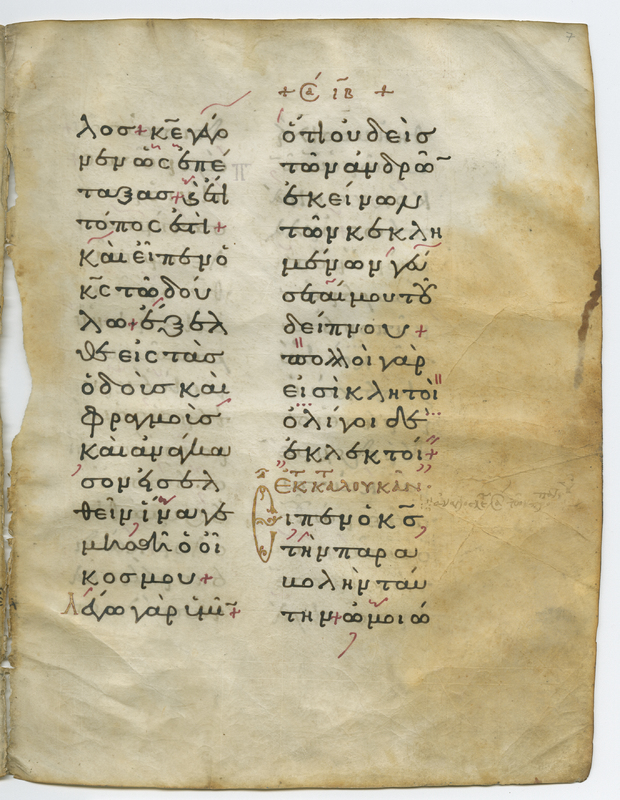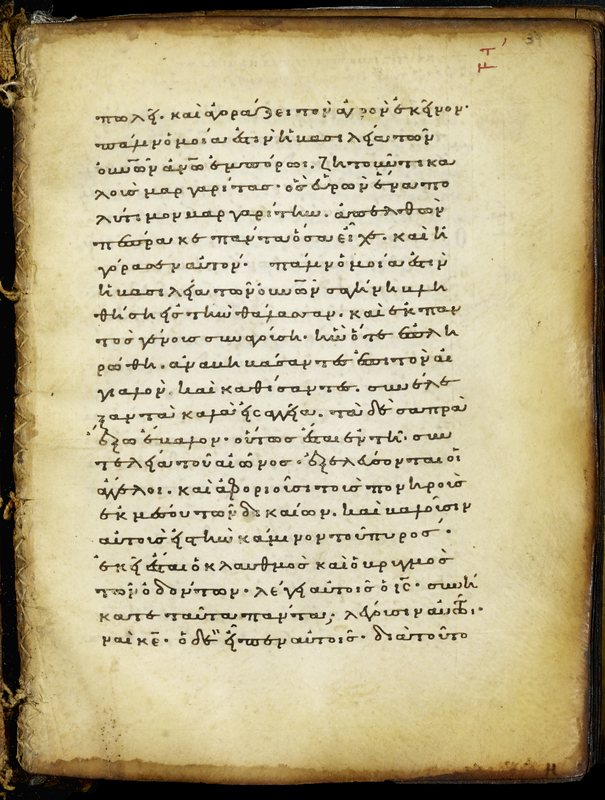The New Testament
The New Testament is the second part of the Bible, consisting of the Gospels (Matthew, Mark, Luke, and John), Acts, the Epistles of Paul and other apostles, and the Apocalypse. Written in the Koine, a common widely spread form of Greek spoken since Hellenistic times, the text of the New Testament was preserved in papyrus and parchment codices, whose earliest witnesses are dated in the second century CE. The text of the New Testament was copied either as part of the Bible, that is, following the Old Testament, or as a separate book, whose various parts could also appear separately in various combinations as exemplified by the manuscripts featured in this exhibit: Gospels (Mich. Mss. 4, 21, 22, 26), The Gospels and Acts (Mich. Ms. 24), and Acts and Epistles (Mich. Ms. 34). One of the featured manuscripts includes patristic commentaries following the Gospels (Mich. Ms. 30).
In 324 CE, Constantine the Great declared Christianity as the official religion of the Roman Empire. In 325 CE, a group of theologians met at the Council of Nicea to establish the theological foundations of Christianity. When Constantine made Byzantium (modern Istanbul) the second capital of the Roman Empire in 330 CE, he would mark the beginning of the eastern, or Byzantine, Empire, initiating a gradual split between the Roman and the Orthodox Churches. This schism was exacerbated in the eleventh century, persisting nowdays: while the Pope in Rome is the head of the Catholic Church, the Patriarch of Constantinople rules over the Eastern Orthodox Church.
In 332 CE, Constantine began the tradition of what we can broadly describe as the "Byzantine Bible" by commissioning fifty codices of the Scriptures, copied in elegant and legible script on well-prepared parchment, for the new churches that he was planning to build in Constantinople. These first Byzantine Bibles were indeed the forerunners of the New Testatment manuscripts shown in this exhibit.
The image above, fol. 83v from Mich. Ms. 22, shows a full page miniature depicting the evangelist Mark, one of the three full-page portraits of the evangelists in this manuscript: Matthew, Mark, and Luke; the portrait of John is missing. The three miniatures are very similar in style with little variation in composition and palette.
The evangelists are portrayed seated on backless chairs covered with cushions with golden tassels. They rest their feet on footstools covered with red cushions. Each evangelist sits in front of a desk with bottles of red and black ink, inkpots, and knives. The desks have tall stands that support scrolls, from which the evangelists are copying the Gospel text. Each Gospel opens with a simple frameless headband executed in magenta ink.
In the image shown above, fol. 39v from Mich. Ms. 22, the Gospel according to Matthew, note that the script shares the features of what scholars denominate early Perlschrift: its name was inspired by the image of "pearls on a string," which is shown by its characteristic preference for circular shapes, and its emphasis for harmonious proportions and spacing.
In general, the script of this manuscript is small, rounded, uniform, and with a slight inclination to the right. Upper and lower strokes of all letters are reduced. These features suggest that the manuscript was executed at the end of the tenth or the first quarter of the eleventh century. Ammonian section and Eusebian canon numbers (these numbers show in which sections each Gospel agreed or differed from the others) and titles were copied by the scribe in magenta ink and placed in the margins. The chapter titles are written in Alexandrian majuscules: the shape, or volume, of this type of letters varies between wide and narrow.
While the main text was copied in the tenth or eleventh century CE, sometime in the first quarter of the twelfth century the manuscript was embellished with the addition of portraits of the evangelists.
The manuscript belonged to Baroness Burdett-Coutts (no. I. 3 in her collection). It was acquired by the University of Michigan at the Burdett-Coutts sale in May 1922. Sotheby, Wilkinson and Hodge, The Burdett Coutts Library, lot 178.
In the page shown above, fol.14r from Mich. Ms. 4, the Gospel according to Mark, from 9:12 onward, note the script, a minuscule bouletée, which means that the rounded shape of the letters recall that of blobs or boules; on the margins there are Ammonian section and Eusebian canon numbers in magenta ink; see the chapter title on top of the page, written with magenta ink in hollow-bar majuscules filled with alternating violet and light green pigment. In other parts of this manuscript fragment, we can see initials executed in hollow-bar style in magenta ink and filled with gold.
This twenty-leaf parchment fragment contains passages from the Gospels of Matthew and Mark: Matt.12:12-13:15; Mark 3:5-10:33. The script is positioned across the ruled lines, suggesting that the date of the manuscript is not later than the first half of the tenth century.
The high quality of calligraphy and decoration suggests a Constantinople ergasterion (workshop). The fragment was purchased in Constantinople by Francis Kelsey during the University of Michigan first expedition in December 1919.
In the image displayed above, fol. 73r from Mich. Ms. 21, the beginning of the Gospel according to Mark, note the headpiece displaying floral and palmette motifs on a gold background; see also the ornamental initial alpha opening this Gospel.
As shown in this page, the script of the manuscript is medium-sized, almost upright with a slight inclination to the right, a professional minuscule, which can be characterized as transitional from the eleventh-century Perlschrift to the new writing styles of the first half of the twelfth century. These new styles are more fluid and incorporate some specific forms of letters and ligatures. Ammonian section numbers and titles and Eusebian canon numbers were executed by the scribe in gold over magenta ink. There are two other headpieces in the manuscript sharing the same type of decoration: floral and palmette motifs on a gold background. Elsewhere in the manuscript, minor initials are in gold over magenta ink.
It is not possible to determine the place of production of this manuscript. In 1493 or 1496 the manuscript was given to the Monastery of the Taxiarch, located in Mantamados (near Mytilene) in Lesbos by a certain Sebastianos (note on fol. 237r). In 1866 the manuscript was owned by an unidentified Demetrios (note on fol. 186v). A few years later it was acquired by Baroness Burdett-Coutts (no. I. 4 in her collection). It was acquired by the University of Michigan at the Burdett-Coutts sale in May 1922. Sotheby, Wilkinson and Hodge, The Burdett Coutts Library, lot 190.
Above is an image of fol. 8r from Mich. Ms. 26, the beginning of the Gospel according to Matthew; note the headpiece and the pen-floriated intial beta.
Mich. Ms. 26 was executed by a scribe called Markos, as he himself stated in chryptographic form in a colophon in fol. 270v. The script is an archaizing minuscule, upright and with reduced upper and lower strokes. Some letters like "elephant-trunk" zetas and "beach-ball" thetas, are extremely large. The titles of the Gospels are written in majuscules. Chapter numbers and titles, and lectionary apparatus, are written in pale brown ink in the margins. Each Gospel opens with a headpiece and pen-floriated initial.
Above is fol. 130v from Mich. Ms. 26, a full page miniature illumination depicting the evangelist Luke. The manuscript was originally illuminated with four full-page portraits of the evangelists, although only two of them are extant, those of Mark (fol. 80v) and Luke (fol. 130v). The miniatures were left unfinished. The bodies, faces and garments were drawn with sepia ink. The gold background in the extant miniatures was a later addition.
The place of execution of this manuscript is unknown but it is plausible that it was copied in northern Greece. The manuscript belonged to Baroness Burdett-Coutts (no. I. 7 in her collection). It was acquired by the University of Michigan at the Burdett-Coutts sale in May 1922. Sotheby, Wilkinson and Hodge, The Burdett Coutts Library, lot 183.
Shown above is fol. 307r from Mich. Ms. 30, the beginning of the Gospel according to John; note the decorated headpiece, with floral decoration and crowned with a blue flame-like ornamentation; note also the pen-floriated initial epsilon. The script of this manuscript is defined as Gebrauchsschrift (utilitarian style) with a strong influence of the writing style practised in the Hodegon monastery in Constantinople.
As stated in the colophon in fol. 390r, Mich. Ms. 30 was executed by a scribe called Theodoros Kotzas from the village of Methoni, probably referring to Methoni, Piera, not far from Thessaloniki (northwestern Greece). The commissioner of the manuscript was a local nobleman, Nikolaos from Lardea (in the Byzantine period Lardea was part of Greek Macedonia and Thrace; now it is in Bulgaria).
Above is fol. 2v from Mich. Ms. 30, displaying canon table II; note the two birds depicted on the top, and a small votive crown hanging from the frame line. In this manuscript, the canon tables were drawn in pale brownish-red ink and decorated with finials and vegetal motifs. Located at the beginning of each Gospel, the canon tables were summaries of the Ammonian section and Eusebian canon numbers.
Apart from canon tables, headpieces, and ornamented initials, the decoration of this manuscript includes six full-page miniatures.
Above is an image of fol. 306v from Mich. Ms. 30, displaying a full-page miniature showing the evangelist John; note the wide frame elaborately ornamented with a vegetal design; the background is bright blue with the inscription, 'Ο ἅγ(ιος) Ιω(άννης) ὁ Θεολόγος (St. John the Theologian).
While the full-page miniatures representing Matthew, Mark, and Luke seem to be unfinished, that is, frameless and lacking background, the miniature of John is fully decorated, probably emphasizing the revered status of the Gospel acording to John.
It was acquired by the University of Michigan at the Burdett-Coutts sale in May 1922. Sotheby, Wilkinson and Hodge, The Burdett Coutts Library, lot 187.

The Provenance of the Collection

The Liturgy









